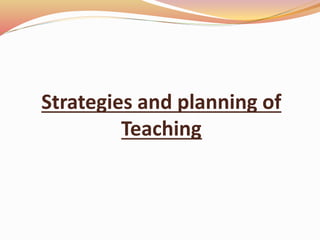
Strategies of teaching.pptx
- 1. Strategies and planning of Teaching
- 3. WHAT IS A TEACHING Activities of educating/ instructing. Activities that impart knowledge or skill. A profession of teacher. “profession of those who give instructions”
- 4. STRATEGIES OF TEACHING There are a variety of teaching strategies that tutors can use to improve students learning. 1. Active Learning 2. Cooperative Learning 3. Critical Thinking 4. Discussion 5. Experimental Learning 6. Games, Experiment And Simulation 7. Humor In class 8. Inquiry Guided Learning
- 5. 1. Active learning Active learning is any learning activity in which the student participates or interacts with the learning process, as opposed to passively taking in the information. When given the opportunity to actively engage with the information they’re learning, students perform better. It nurtures the brain, giving it an extended opportunity to connect new and old information, correct previous misconceptions, and reconsider existing thoughts or opinions. Examples 1. class discussion 2. think-pair-share 3. short written exercise 4. collaborative learning group 5. student debate 6. reaction to a video 7. class game
- 7. 2. Cooperative learning It is an approach to organizing classroom activities into academic and social learning experiences. Students must work in groups to complete tasks collectively. Unlike individual learning, students learning cooperatively capitalize on one another’s resources and skills (asking one another for information, evaluating one another’s ideas, monitoring one another’s work, etc.). Furthermore, the teacher's role changes from giving information to facilitating students' learning. Everyone succeeds when the group succeeds.
- 10. 3. Critical thinking Critical thinking is the process or method of thinking that questions assumptions. Critical thinking is the ability to think clearly and rationally, understanding the logical connection between idea. In essence, critical thinking requires you to use your ability to reason. It is about being an active learner rather than a passive recipient of information. “reasonable reflective thinking focused on deciding what to believe or do.” Critical thinkers rigorously question ideas and assumptions rather than accepting them at face value. They will always seek to determine whether the ideas, arguments and findings represent the entire picture and are open to finding that they do not. for example the ability to recognise fake news.
- 13. 4. Discussion strategies Engaging students discussion deepens their learning and motivation by propelling them to develop their own views and listen to their own voices.
- 14. 5. Experimental learning It is an approach to education that focuses on learning by doing on the participants subjective experience.
- 15. Example going to the zoo and learning through observation and interaction with the zoo environment, as opposed to reading about animals from a book. Thus, one makes discoveries and experiments with knowledge firsthand, instead of hearing or reading about others' experiences
- 16. 6. Games, experiment and simulation These can be rich experience for learning environment for students. These enable students to solve real work problems in safe environments.
- 17. Simulation Artificial models, standardized/simulated patients, role play It is the imitation of some real thing available, state of affairs, or process. The act of simulating something generally entails representing certain key characteristics or behaviors of a selected physical or abstract system.
- 18. 7. Humor in class Humor in class can enhance students learning by improving understanding and attention.
- 19. 8. Inquiry guided learning Inquiry learning is a form of active learning, where progress is assessed by how well students develop experimental and analytical skills rather than how much knowledge they possess. In such a learning method, student understand concept by themselves and responsible of learning rests with them.
- 21. EXAMPLE Students develop a method to find which antacid tablets are the best at neutralizing acids. Students learn about inertia and movement by studying the effects of rolling of marbles on different surfaces.
- 22. Main steps in planning of teaching Once you have decided in broad terms what you want to teach, to whom, and why you want to teach it, you need to: Set your teaching objectives (Because these objectives are for the learners, it is strongly recommended to discuss/develop these with the learners.) Choose your teaching methodologies for meeting your teaching objectives. Decide how you will evaluate your teaching outcomes to see if you have met your objectives.
- 23. THANK YOU